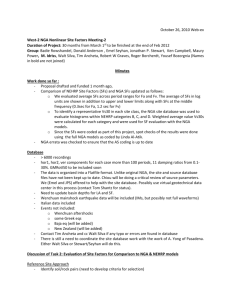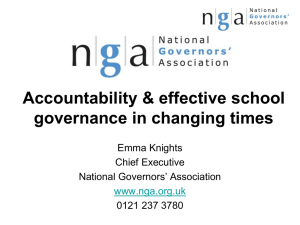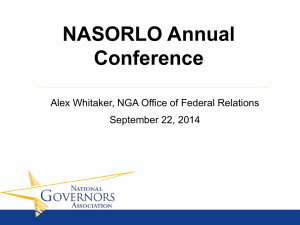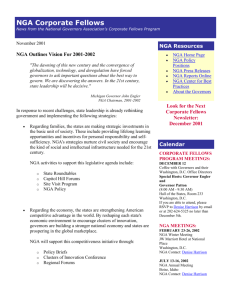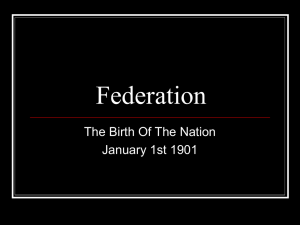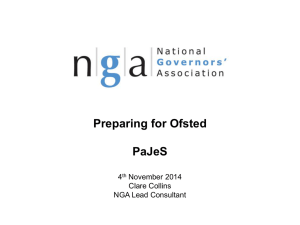The Road to Federation
advertisement
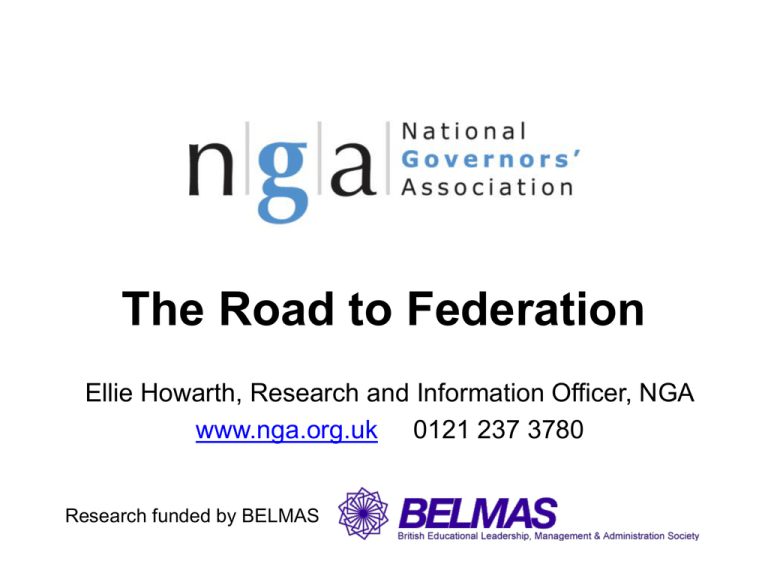
The Road to Federation Ellie Howarth, Research and Information Officer, NGA www.nga.org.uk 0121 237 3780 Research funded by BELMAS Background • Education Act 2002: Federated schools “have a single governing body constituted under a single instrument of government.” • Benefits1: – Improving governance in weaker schools – Improving teaching and learning, achievement and behaviour – Pooling of resources and expertise – Attracting and retaining staff • Multi-academy trusts (MATs) • Lord Nash: federation is a “second best model” 1. Ofsted (2011) Leadership of more than one school © NGA 2014 www.nga.org.uk 2 Research objectives • What are the drivers of the formation of federations/multi-academy trusts? • Who is involved in the decision-making process and how do they influence the decision? • What are the barriers, perceived and actual? © NGA 2014 www.nga.org.uk 3 Drivers • School improvement, often sharing a successful headteacher • Small, rural schools: professional leadership, finance, staffing • Recruiting a headteacher • Streamlining governance © NGA 2014 www.nga.org.uk 4 The federation process • Final decision lies with governing body • Proposals must be sent to: Secretary of State, local authority, headteacher of each school, staff, parents, diocese, foundation governors/trustees. • Barriers: – Stakeholder opposition – Lack of information © NGA 2014 www.nga.org.uk 5 Conclusions • Despite its low profile, federation is an attractive option for many schools • Professional leadership arrangements were a key factor in the decision whether to federate • Lack of information can be a barrier • Communication with stakeholders is vital in the federation process © NGA 2014 www.nga.org.uk 6 Acknowledgements We are grateful to the British Educational Leadership, Management and Administration Society for funding this research © NGA 2014 www.nga.org.uk 7 Case study Background • Shacklewell Primary School, Hackney, east London • Two forms of entry, ethnically diverse, large proportion of children eligible for FSM • 2009, 2010: two years of significant under-performance Step 1: Creation of a “soft” federation • • • • LA-brokered relationship with a local high-performing primary school Executive headteacher model Challenging decision for the governing body – perceptions vs. reality Two years on: very significant improvement in the achievement of pupils © NGA 2014 www.nga.org.uk 8 Step 2: Creation of a “hard” federation • Decision-making process strongly owned by governors • Options appraisal: end, extend, or enter into a “hard” federation • Consultation with parents, staff, wider community – effectively supported by the LA; most interest from parents at the highperforming school • Joint meeting of the two governing bodies, unanimous vote for federation Reflections • Federation unfamiliar to most people and little information to draw on • Creation of the “soft” federation was the most significant step, but this is not strongly featured in the guidance that does exist • Stay focused on what is in the best interests of children © NGA 2014 www.nga.org.uk 9 What difference has federation made? Percentage of Year 6 pupils achieving Level 4+ in English and Maths 100% 90% 80% 70% 60% 50% 2009 2010 2011 2012 2013 Federation © NGA 2014 www.nga.org.uk 10
